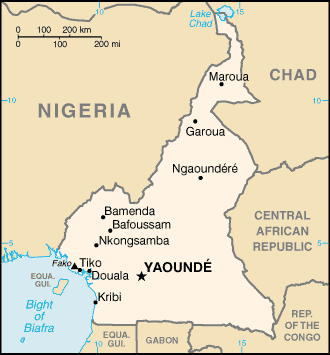Geography of Cameroon
|
|
Location: Western Africa, bordering the Bight of Biafra, between Equatorial Guinea and Nigeria
Geographic coordinates: Template:Coor d
Map references: Africa
Area:
total:
475,440 km²
land:
469,440 km²
water:
6,000 km²
Area - comparative: slightly larger than California
Land boundaries:
total:
4,591 km
border countries:
Central African Republic 797 km, Chad 1,094 km, Republic of the Congo 523 km, Equatorial Guinea 189 km, Gabon 298 km, Nigeria 1,690 km
Coastline: 402 km
Maritime claims:
territorial sea:
50 nm
Climate: varies with terrain, from tropical along coast to semiarid and hot in north
Terrain: diverse, with coastal plain in southwest, dissected plateau in center, mountains in west, plains in north
Elevation extremes:
lowest point:
Atlantic Ocean 0 m
highest point:
Fako 4,095 m
Natural resources: petroleum, bauxite, iron ore, timber, hydropower
Land use:
arable land:
13%
permanent crops:
2%
permanent pastures:
4%
forests and woodland:
78%
other:
3% (1993 est.)
Irrigated land: 210 km² (1993 est.)
Natural hazards: Recent volcanic activity with release of poisonous gases from Lake Nyos, August 21, 1986, killing 1700
Environment - current issues: water-borne diseases are prevalent; deforestation; overgrazing; desertification; poaching; overfishing
Environment - international agreements:
party to:
Biodiversity, Climate Change, Desertification, Endangered Species, Law of the Sea, Ozone Layer Protection, Tropical Timber 83, Tropical Timber 94
signed, but not ratified:
Nuclear Test Ban
Geography - note: sometimes referred to as the hinge of Africa
- See also : Cameroonfr:Géographie du Cameroun

